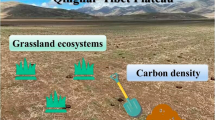Abstract—The aim of this study was to evaluate morphologic features, diagnostic qualifiers and enhance classification of alluvial-meadow soils in the floodplain of the Kur River within Azerbaijan. For this purpose, several soil pits were placed in the representative test areas and multiple soil samples collected within field campaigns (2014–2015). Based on the field and laboratory test data, the detailed soil maps of the test areas were compiled, and diversity of alluvial-meadow soils was classified as suborders (subtypes): alluvial-meadow primitive; alluvial-meadow layered (flaggy); alluvial-meadow dark and alluvial-meadow irrigated. It was found out that in the floodplains, local soil variability was predominantly attributed to not only alluvial sediments, but also water table, mineralization rate and salt content of underground water as well flood water play an important role. The mineralization of ground water is weak (1.40–3.70 g/L) and the concentration of hydro-carbonates (HCO3) varies from 0.56 to 0.92 g/L. No salinization indication found in the profile of alluvial-meadow primitive and alluvial-meadow layered soils, while weak concentration (solid content = 0.40–0.54%) was found at a depth of 80–150 cm in the alluvial-meadow dark soil. Unlike other subtypes, alluvial-meadow dark soil is characterized with the higher biomass (green weight of top = 41.5 c/h and green weight of underground = 142.3 c/h), high mobility of humus substances with predominance of the 1st fraction of humin (20.0–28.1%) and fulvic acids (14.6–22.3%). The ratio of Ch.a : Cf.a reaches 1.18–1.32. For the alluvial-meadow irrigated soil, the second fraction of humin acid (9.3–10.2%) and total content of humin acid ranges from 45.6 to 50.3%. The ratio of Ch.a : Cf.a is larger (1.37–1.50). Depending on the litho logy of alluvial sediments, the content of SiO2 and R2O3 varies in the ranges of 53.0–57.2 and 9.6–26.0%, respectively. For the alluvial-meadow dark soil, decomposition of alum silicates in alkaline hydrolysis is typical (8.7–9.0). The content of SiO2 and R2O3 varies between 47.8 and 50.6%, and 19.7 and 21.6%, respectively. In the topsoil, of the irrigated soils in associated to washing out the content of Ca and CaO content (12.2–13.1%) increases in deeper horizons.
Similar content being viewed by others
REFERENCES
Bernal, J.D., Science in History, Watts, 1954.
Vladichensky, S.A., Soil genesis of Volga-Akhtubin floodplain and Volga delta, Soil Sci., 1953, no. 11, pp. 64–84.
Dobrovolsky, G.V., Soils of the River Floodplains in the Centre of Russian Plain, Moscow: Mosk. Gos. Univ., 1968.
Kovda, V.A., Soil forming process in deltas and river floodplains of the continental regions, in Problemy Sovetskogo Pochvovedeniya (Problems of Soviet Soil Science), Moscow, 1946, vol. 14, p. 350.
Hasanov, V.H., V.A. Kovda’s ideas about study of genesis and evolution of floodplain-alluvial soils in arid subtropics of Azerbaijan, Materials of Scientific Session on Fundamental Soil Science, Moscow, 2004, pp. 138–139.
Hasanov, V.H. and Ismayilov, B.N., Morphological diagnostics and nomenclature of alluvial-meadow soils in Ganig-Agrichaisky valley, Vestn. Ryazan. Gos. Agrotech. Univ. im. P. A. Kostycheva, 2016, no. 2, pp. 12–18.
Hasanov, V.H. and Ismayilov, B.N., Morphogenetical diagnostics of alluvial meadow-forest soils in dry subtropics in the flood-lands of Azerbaijan, Soil-Water J., 2013, vol. 2, no. 2, 1167–1176.
Volobuyev, V.R., Genetic Forms of Soil Salinization of the Kur-Araz Volley, Baku: Akad. Nauk Azerb. SSR, 1965.
Hasanov, V.H., Soil floodplain and low forests of Azerbaijan, in Morphogenetic Profile of Azerbaijan Soils, Baku: Elm, 2004, pp. 112–132.
Hasanov, V.H., Conditions of soil formation and morphogenetic diagnostics in alluvial-meadow buried soils of the river floodplains in Azerbaijan, Tr. Inst. Probl. Inf. Avtom. Nats. Akad. Nauk Arm., 2011, vol. 19, pp. 37–53.
Babaev, M.P., Hasanov, V.H., Jafarova, Ch.M., and Huseynova, S.M., Morphogenetic Diagnostics, Nomenclature and Classification of Soils in Azerbaijan, Baku: Elm, 2011.
Classification and Diagnostics of the USSR Soils, Moscow: Kolos, 1977.
IUSS Working Group WRB,World Reference Base for Soil Resources 2014. International Soil Classification System for Naming Soil and Creating Legends for Soil Maps. World Soil Resources Reports No. 106, Rome: FAO, 2014.
Shishov, L.L. and Tonkonogov, V.D., Lebedeva, I.I., and Gerasimova, M.I., Classification and Diagnostics of Soils in Russia, Smolensk: Oikumena, 2004.
Kovda, V.A., Learning Basics of Soils, Moscow: Science, 1973, vol. 2.
Author information
Authors and Affiliations
Corresponding author
Ethics declarations
The authors declare that they have no conflict of interest. This article does not contain any studies involving animals or human participants performed by any of the authors.
About this article
Cite this article
Hasanov, V.H. Morphogenetic Diagnostics and Nomenclature of Alluvial-Meadow Soils in the Subtropical Semiarid Area, Floodplain of the Kur River, Azerbaijan. Russ. Agricult. Sci. 46, 257–263 (2020). https://doi.org/10.3103/S1068367420030040
Received:
Published:
Issue Date:
DOI: https://doi.org/10.3103/S1068367420030040




